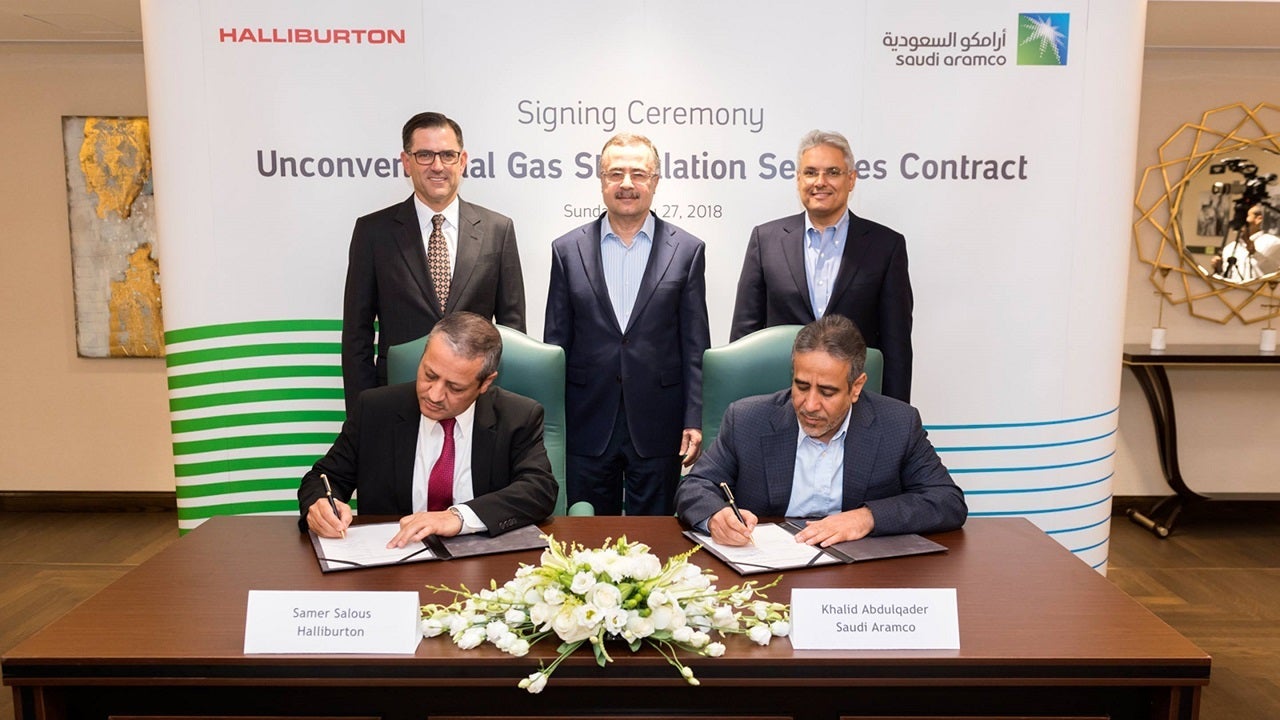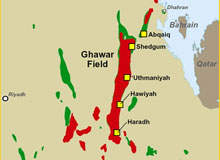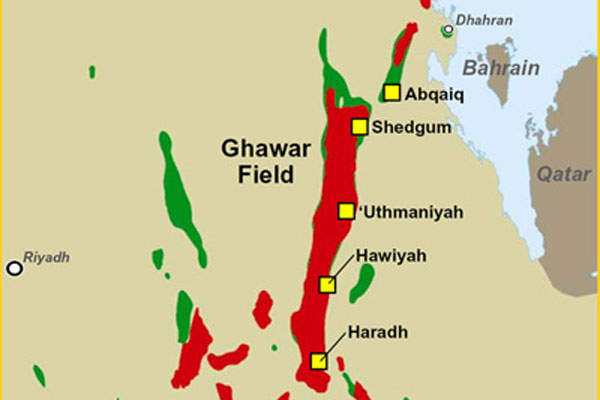The Ghawar oilfield, located about 100km southwest of Dhahran in the Al Hasa Province of Saudi Arabia, is the world’s biggest conventional oil field both by oil reserves and production. The giant oil field, discovered in 1948 and brought on-stream in 1951, currently holds more than a quarter of Saudi Arabia’s total proven oil reserves and accounts for about half of the country’s oil output.
Owned and operated by state-owned Saudi Aramco, the Ghawar field produces Arabian light crude oil and continues to undergo development for greater productivity and extended life.
Ghawar reservoir details
Ghawar reservoir is 280km-long and 40km-wide underlying 1.3million acres, making it the world’s largest oil reservoir. It is situated in the eastern part of the Empty Quarter desert, along the western Gulf coast.
The main reservoir of the field, 100m in thickness and lying 2,100m beneath the surface, comprises highly porous and permeable Arab-D Jurassic organic-rich mudstones.
The field was estimated to contain proved reserves totalling 58.32 billion barrels of oil equivalent, including 48.25 billion barrels of liquids reserves as at December 2018.
Ghawar field discovery wells
The onshore oil field comprises six development areas namely Fazran, Ain Dar, Haradh, Uthmaniyah, Shedgum, and Hawiyah.
The field’s first discovery well Ain Dar No. 1 was completed in 1948 and brought into production in early 1951 at a rate of 15,600 barrels per day (bpd). The well continued to produce dry oil without any water contamination until 1999.
Haradh No. 1, the second discovery well at Ghawar, was completed in 1949, but put on production in 1964 at a rate of 6,400bpd.
The Uthmaniyah No. 1 discovery well was drilled in 1951 and brought on-stream in 1956 at a rate of 11,300 bpd.
The fourth discovery well Shedgum No. 1, completed in 1952, was put into production in 1954 at a rate of 12,400 bpd.
The fifth discovery well Hawiyah No. 1, confirming oil between Uthmaniyah and Haradh, was drilled in 1953 and brought on-stream in 1966 at a rate of 4,800 bpd.
Oil and gas production from Ghawar
The Ghawar field currently produces about 3.8 million barrels of oil and 2.5 billion cubic feet of natural gas per day. It is by far the biggest oil-producing field and is one of the world’s six fields producing more than one million barrels of oil per day. The offshore field Safaniya and the onshore fields Khurais and Shaybah are the only other Saudi Arabian fields with daily oil output exceeding one million barrels per day.
Ghawar is estimated to account for about 6% of the world’s total daily crude oil output. The field’s production peaked at 5.7 million barrels per day in 1981 and later slipped below the five million. The development of the southern Hawiyah and Haradh areas during 1994 and 1996, however, raised the production to five million barrels per day again.
Technologies employed at the Ghawar field
Gas injection was introduced at Ghawar in 1958. Water injection began in 1964 to provide additional pressure support. The field’s current extensive injection system utilises water pumped via pipeline from the Qurayyah Seawater Treatment Plant which processes about seven million barrels of Persian Gulf seawater per day.
A comprehensive 3D seismic survey was conducted across the field in 1995 to obtain vital information regarding the reservoir structure and distribution of fractures for guiding the future development of the field.
The Haradh III project, one of the recent development projects at Ghawar that came on stream in 2006, was the first Saudi Aramco project to be developed with maximum-reservoir-contact (MRC) wells with down-hole interval control valves (ICVs) for flow control. The project also utilised the innovative geo-steering technology for optimal placement of wells for maximum recovery and the intelligent field concept that allowed continuous monitoring of key reservoir indicators through real-time sub-surface data transmission.
Recent developments at Ghawar
Ghawar had more than 3,000 injector and oil producer wells excluding the gas wells by the end of 2012. Halliburton was awarded five-year oilfield service contract by Saudi Aramco in November 2009 to develop up to 185 oil production, water injection and evaluation wells at the world’s biggest oil field. Saudi Aramco developed a carbon capture and storage (CCS) project at Ghawar with an aim to demonstrate enhanced oil recovery (EOR) at the field through carbon dioxide (CO2) injection. Approximately 40 million cubic feet of gas was pumped from the Hawiyah and Uthmaniyah gas processing plants a day as part of the CCS project, which was launched in July 2015. The project, also known as the Uthmaniyah CO2-EOR Demonstration Project, involves an 800,000t/y CCS facility and a 70km onshore pipeline to transport CO2 to the injection site.
The company completed wells with high gas and condensate flows in south Ghawar by 2017, as well as well design optimisation and implementation of fit-for-purpose technologies to reduce drilling costs.
The company plans to increase gas plant utilisation and increase the availability of gas in summers through the implementation of a gas storage system using a partially depleted gas reservoir in the Ghawar area.




